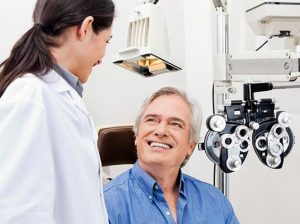medical eye exams
Don’t wait any longer…See clearly again
Exam Elements: It’s not just about glasses
An eye exam not only tests for visual impairment, but also for other underlying health issues. Even if you do not feel like you need glasses, many asymptomatic conditions exist that can be identified early on with an eye exam. By having regular complete eye exams at Falgoust Eye Medical & Surgical, you can ensure that your eyes are receiving the best care possible during all stages of life. A complete eye exam involves a series of tests designed to evaluate your vision and check for eye diseases. At Falgoust Eye, we utilize a variety of instruments and have you look through an array of lenses. Each test during an eye exam evaluates a different aspect of your vision or eye health.
When to have an eye exam
An eye exam helps detect eye problems at their earliest stage — when they’re most treatable. Regular eye exams give Dr. Falgoust and Dr. Cornner the chance to help you correct or adapt to vision changes and provide you with tips on caring for your eyes. General guidelines for eye care include:
- Children 5 years and younger. For children under 3, your pediatrician will likely look for the most common eye problems — lazy eye, crossed eyes or turned-out eyes. Depending on the results at your pediatrician, your child’s first more comprehensive eye exam should be done between the ages of 3 and 5.
- School-age children and adolescents. Have your child’s vision checked before he or she enters first grade. Vision screenings are often performed by your pediatrician and school. If there is any family history of eye problems at a young age, a comprehensive exam in our office is recommended. If your child does have vision problems or a family history of vision problems, have your child’s vision rechecked as advised by your pediatrician or one of our doctors.
- Adults. In general, if you’re healthy and have no symptoms of vision problems, you should have your vision checked every two to five years in your 20s and 30s. Between ages 40 and 65, have your vision checked every two to four years. After age 65, get your eyes checked every one to two years. If you wear glasses, have a family history of eye disease or have a chronic disease that puts you at greater risk of eye disease, such as diabetes, have your eyes checked more frequently.
Routine and Medical Eyecare
The care of your eyes includes routine vision exams and medical exams. Many medical insurance plans do not cover routine vision exams. Any questions regarding your specific coverage, including referrals and authorizations, should be directed to your insurance company or your company benefits administrator. You are responsible for any amount not covered by your plan.
What Dilating Eyedrops Do to Your Eyes
Dilating eyedrops (called mydriatics) are used to dilate, or enlarge, the pupils of your eyes so that your eye doctor can see the inside of your eye in detail.
Dilating drops work in one of three ways:
- By temporarily paralyzing the muscle that makes the pupil smaller;
- By stimulating the muscle that makes the iris (the colored part of the eye) widen; or
- By preventing the pupil from adjusting for focus (called accommodation).
When Dilating Eyedrops Are Necessary
With your pupils dilated, your eye doctor can use special instruments to see the eye’s entire lens, which focuses light onto the retina (the light-sensitive tissue lining the back of the eye). The retina itself also can be seen, as well as the optic nerve, which sends signals from the retina to your brain where they are interpreted as images.
In addition to exams, dilating eyedrops are used for a variety of purposes. For some types of eye surgery, your ophthalmologist will need to dilate your eyes. Sometimes, after certain types of surgery, it is important to use dilating drops to keep the pupil wide so that scar tissue will not form. Your eyes may also be dilated to relax your lens’s focusing muscles, so that your eye doctor can measure accurately for your glasses prescription.
Dilating drops are sometimes used in children who have amblyopia (lazy eye). Because the drops cause temporary blurry vision, they are used to blur the stronger eye, thereby forcing the child’s brain to use the weaker eye.
Duration And Dilation Effects
It usually takes 20 to 30 minutes for dilating eyedrops to begin working. People with light eye color (such as blue, green or hazel) are more sensitive and dilate faster than people with dark eye color (brown). With dilated pupils, you will be sensitive to light and you will find it difficult to focus on nearby objects. These effects can last for up to several hours, depending on the strength of the drop used and on each individual.
When you are going to have a dilated eye exam or procedure, you should bring sunglasses with you to minimize glare and light sensitivity when you leave your appointment. Dilating eyedrops cause a variable amount of blurry vision for an unpredictable length of time. The most common drops we use last between 3 to 5 hours. Your eye doctor cannot tell you how much your vision will be affected and for exactly how long. Because driving safely may not be possible after having your eyes dilated, you should make arrangements to have someone drive you after your appointment.
If you have any questions before or after a dilated eye exam or procedure, be sure to speak with your doctor.




